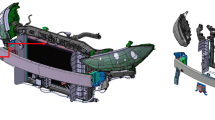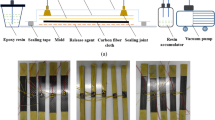Abstract
The application of polymer composites as a substitution of metal is an effective approach to reduce vehicle weight. However, the final performance of composite structures is determined not only by the material types, structural designs and manufacturing process, but also by their mutual restrict. Hence, an integrated “material-structure-process-performance” method is proposed for the conceptual and detail design of composite components. The material selection is based on the principle of composite mechanics such as rule of mixture for laminate. The design of component geometry, dimension and stacking sequence is determined by parametric modeling and size optimization. The selection of process parameters are based on multi-physical field simulation. The stiffness and modal constraint conditions were obtained from the numerical analysis of metal benchmark under typical load conditions. The optimal design was found by multi-discipline optimization. Finally, the proposed method was validated by an application case of automotive hatchback using carbon fiber reinforced polymer. Compared with the metal benchmark, the weight of composite one reduces 38.8%, simultaneously, its torsion and bending stiffness increases 3.75% and 33.23%, respectively, and the first frequency also increases 44.78%.












Similar content being viewed by others
References
Solazzi, L., Scalmana, R.: New design concept for a lifting platform made of composite material. Appl. Compos. Mater. 20, 615–626 (2013)
Cao, S., Zhis, W.U., Wang, X.: Tensile properties of CFRP and hybrid FRP composites at elevated temperatures. J. Compos. Mater. 43, 315–330 (2009)
Kim, P.: A comparative study of the mechanical performance and cost of metal, FRP, and hybrid beams. Appl. Compos. Mater. 5, 175–187 (1998)
Yuan, C., Bergsma, O., Koussios, S., Zu, L., Beukers, A.: Optimization of sandwich composites fuselages under flight loads. Appl. Compos. Mater. 19, 47–64 (2012)
Liu, T.J.C., Wu, H.C.: Fiber direction and stacking sequence design for bicycle frame made of carbon/epoxy composite laminate. Mater. Des. 31, 1971–1980 (2010)
Pohlak, M., Majak, J., Karjust, K., Küttner, R.: Multi-criteria optimization of large composite parts. Compos. Struct. 92, 2146–2152 (2010)
Gnädinger, F., Karcher, M., Henning, F., Middendorf, P.: Holistic and consistent design process for hollow structures based on braided textiles and RTM. Appl. Compos. Mater. 21, 541–556 (2014)
Gandhi, U., Song, Y.Y., Mandapati, R.: Semiempirical approach to predict shrinkage and warpage of fiber-reinforced polymers using measured material properties in finite element model. J. Thermoplast. Compos. Mater. 30, 1303–1319 (2017)
Gantois, K., Morris, A.J.: The multi-disciplinary design of a large-scale civil aircraft wing taking account of manufacturing costs. Struct. Multidiscip. Optim. 28, 31–46 (2004)
Olson, G.B.: Computational design of hierarchically structured materials. Science. 277, 1237–1242 (1997)
Grujicic, M., Arakere, G., Sellappan, V., Ziegert, J.C., Schmueser, D.: Multi-disciplinary design optimization of a composite car door for structural performance, NVH, crashworthiness, durability and manufacturability. Multidiscip. Model. Mater. Struct. 5, 1–28 (2009). https://doi.org/10.1108/15736105200900001
Zhang, C., Kang, N., Li, L.J., Sun, L.Y.: Case Study: ‘Material-Structure-Process-Performance’ Integration Design and Numerical Verification of Automotive Composite Components. International Mechanical Engineering Congress and Exposition (ASME), Tampa (2017)
Wang, H., La Rocca, G., van Tooren, M.J.L.: A KBE–Enabled Design Framework for Cost/Weight Optimization Study of Aircraft Composite Structures. AIP Conference Proceedings (AIP), Louisiana (2014)
Choi, J.W., Kelly, D., Raju, J.: A knowledge-based engineering tool to estimate cost and weight of composite aerospace structures at the conceptual stage of the design process. Aircr. Eng. 79, 459–468 (2007)
McDowell, D.L.: Simulation-assisted materials design for the concurrent design of materials and products. JOM. 59, 21–25 (2007)
Marom, G., Fischer, S., Tuler, F.R., Wagner, H.D.: Hybrid effects in composites: conditions for positive or negative effects versus rule-of-mixtures behaviour. J. Mater. Sci. 13, 1419–1426 (1978)
Chamis, C.C.: Mechanics of composite materials: past, present, and future. J. Compos. Technol. Res. 11, 3–14 (1989)
Kalamkarov, A. L., Kolpakov, A.G.: Analysis, Design, and Optimization of Composite structures. Wiley, New York (1997)
Trochu, F., Ruiz, E., Achim, V., et al.: New Approaches to Accelerate Calculations and Improve Accuracy of Numerical Simulations in Liquid Composite Molding. International Conference on Flow Processes in Composite Materials (FPCM), Delaware (2004). https://www.fose1.plymouth.ac.uk/sme/fpcm/fpcm07/Extended_abstracts/EA255.pdf
Zhou, J., Sancaktar, E.: Chemorheology of epoxy/nickel conductive adhesives during processing and cure. J. Adhes. Sci. Technol. 22, 957–981 (2008)
Kamal, M.R., Sourour, S.: Kinetics and thermal characterization of thermoset cure. Polym. Eng. Sci. 13, 59–64 (1973)
Daniel, I.M., Ishai, O., Daniel, I.M., et al.: Engineering Mechanics of Composite Materials. Oxford University Press, New York (1994)
Suresh, S., Sujit, P.B., Rao, A.K.: Particle swarm optimization approach for multi-objective composite box-beam design. Compos. Struct. 81, 598–605 (2007)
Marklund, P.O., Nilsson, L.: Optimization of a car body component subjected to side impact. Struct. Multidiscip. Optim. 21, 383–392 (2001)
Kodiyalam, S., Yang, R.J.: Optimization of car body under constraints of noise, vibration, and harshness (NVH), and crash. Struct. Multidiscip. Optim. 22, 295–306 (2001)
Craig, K.J., Stander, N., Dooge, D.A., Varadappa, S.: Automotive crashworthiness design using response surface-based variable screening and optimization. Eng. Comput. 22, 38–61 (2005)
Bendsøe, M.P., Kikuchi, N.: Generating optimal topologies in structural design using a homogenization method. Comput. Methods Appl. Mech. Eng. 71, 197–224 (1988)
Trochu, F., Gauvin, R., Gao, D.M.: Numerical analysis of the resin transfer molding process by the finite element method. Adv. Polym. Technol. 12, 329–342 (1993)
Acknowledgements
Xudong Yang and Lingyu Sun would like to thank the support from the National Natural Science Foundation of China (No. U1664250 and No. 51575023). Lingyu Sun and Lijun Li would like to thank the support from the National Key Research and Development Program of China (No. 2016YFB0101606). Lijun Li would like to thank the Joint Fund of China Shipbuilding Industry Corporation (CSIC) Equipment Pre-research (No. 6141B04010403).
Author information
Authors and Affiliations
Corresponding author
Rights and permissions
About this article
Cite this article
Yang, X., Sun, L., Zhang, C. et al. Design and Optimization of Composite Automotive Hatchback Using Integrated Material-Structure-Process-Performance Method. Appl Compos Mater 25, 1455–1475 (2018). https://doi.org/10.1007/s10443-018-9677-1
Received:
Accepted:
Published:
Issue Date:
DOI: https://doi.org/10.1007/s10443-018-9677-1




